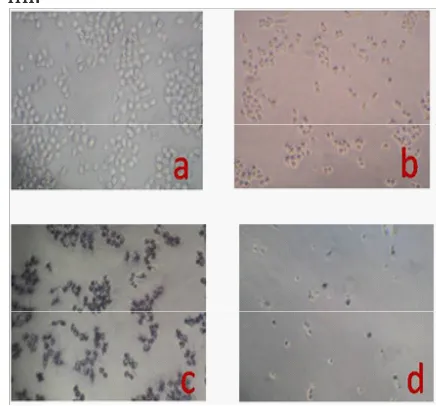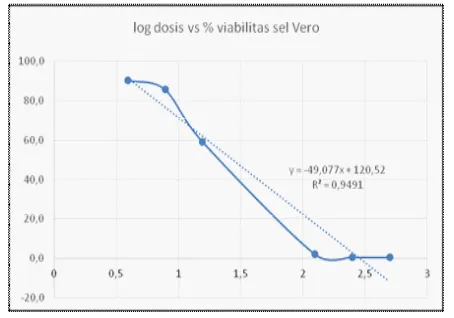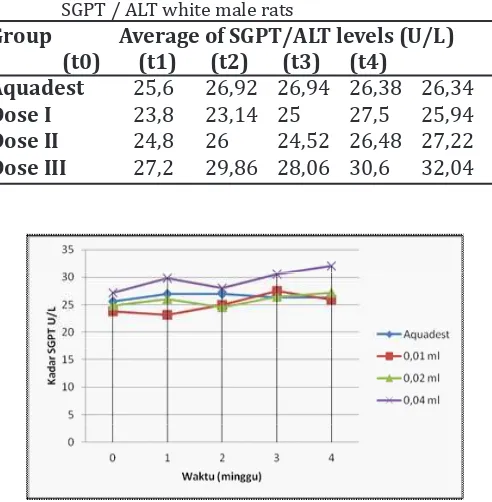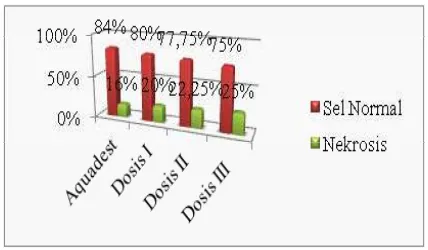Efek Sitotoksisitas Minyak Kayu Manis Terhadap Kultur Sel
WiDr & Vero Serta Efek Toksisitas Subkronis Minyak Kayu Manis Pada Kadar ALT/
ASL Tikus Putih Jantan
W Herdwiani, F Leviana, Z Imama, Sari, AA Soemardji, Elfahmi, MI Tan Faculty Of Pharmacy, Setia Budi University, Surakarta
School Of Pharmacy, Institut Of Technology Bandung E-mail: herdwiani@gmail.com
ABSTRAK
Lebih dari 1 juta kasus kanker terjadi setiap tahun dan separuhnya berada di negara-negara berkembang. Pengem-bangan pengobatan alternatif pada kanker saat ini menjadi perhatian penting dikarenakan kegagalan kemoterapi konvensional. Karya ini telah membahas potensi antineoplastik Minyak Cinnamon kanker. Penelitian ini bertujuan untuk mengetahui efek cytotoxity dari Cinnamon Oil On sel kolorektal budaya kanker (WiDr) dan normal Kultur Sel (Vero) dan efek toksisitas subkronis minyak kayu manis Pada Pria Rat. Efek Sitotoxic dari WiDr sel kultur dan bu-daya Vero sel dilakukan oleh MTT assay, untuk mendapatkan nomor IC50 dan pengujian toksisitas subkronis
meng-gunakan 20 tikus jantan dan dibagi menjadi 4 kelompok. Setiap kelompok diberi perlakuan minyak kayu manis dalam dosis perbedaan, pertama kelompok 50 mg / kg BB, kelompok kedua 100 mg / kg BB, kelompok ketiga 200 mg / kg BB dan kelompok terakhir kontrol negatif. Data diperoleh dari pemeriksaan SGPT / ALT nad SGOT / AST sebelum dan sesudah perlakuan pada tanggal 1, 2, minggu ke-3 dan ke-4 dan tokoh histopatologi hepar pada akhir minggu ke-4. Hasil Data dianalisis dengan menggunakan SPPS. Hasil penelitian menunjukkan bahwa minyak kayu manis memiliki IC50 WiDr dan Vero sel kultur 38,02 mg / ml dan 27,35 mg / ml masing-masing. Minyak Cinnamon
tidak memiliki efek toksisitas subkronis pada hepar tikus putih jantan.
Kata kunci: kayu manis, sitotoksisitas, WiDr, toksisitas
ABSTRACT
More than 1 million cancer cases occur each year and half are in developing countries. Attention towards new alternative was invited by the failure of conventional chemotheraphy. The present work has addressed the anti-neoplastic potential of the Cinnamon Oil in cancer. This research aims to investigate cytotoxity effect of Cinnamon Oil On colorectal cancer culture cells (WiDr) and normal Culture Cell (Vero) and subchronic toxicity effect of cin -namon oil On Male Rat. Sitotoxic effect of WiDr culture cell and Vero culture cell were done by MTT assay, to get an IC50 number and subchronic toxicity testing using 20 male rat and were divided into 4 groups. Each group was given treatment of cinnamon oil in difference doses, first group 50 mg/kg BW, second group 100 mg/kg BW, third group 200 mg/kg BW and the last group negative control. The data were obtained from the examination SGPT/ ALT nad SGOT/AST before and after treatment on 1st, 2nd, 3rd and 4th week and histopathological figures of the hepar at the end of 4th week. The data results were analyzed using SPPS. The results showed that cinnamon oil had an IC50 of WiDr and Vero culture cell 38,02 µg/ml and 27,35 µg/ml respectively. Cinnamon oil had no sub -chronic toxicity effect on the hepar of white male rat.
Cancer is the second after heart disease as a leading cause of death in the United States
and British (Dipiro, 2008). According to WHO,
more than 1 million cases occur each year and more than half are in developing countries
(Aapro, 2007). Cancer (a malignant tumor) is
present when the tumor tissue destructively invades healthy surrounding tissue or when dislodged tumor cells form secondary tumors
(metastases) in other organs (Heinz et al.,
2000).
Cytotoxic substances that particularly
affect proliferating or dividing cells are cyto
-statics. Not only retards tumor growth but also
initiate apoptosis (programmed cell death)
damage to mitotic processes. Because tissues have a physiologically high mitotic rate, so they
can be affected by cytostatic therapy. There are adverse effects of cytostatic therapy i.e loss
of hair, gastrointestinal disturbances, nause-vomiting, lowered resistance to infection and
bone marrow depression (Heinz et al., 2000).
Attention towards new alternative was invited by the failure of conventional chemo-therapy to reduce mortality. Approaches that
would reduce morbidity as well as side effects
were conferred by conventional chemotherapy.
A source of effective anticancer agents, plants have played a significant role. About 60% of
currently used anticancer drugs are derived from natural sources such as plants, marine
organisms and microorganisms (Rocha et al.,
2001; Mann, 2002; Deorukhkar et al., 2007).
Several studies have been conducted on herbs that possess anticancer properties and have been used as potent anticancer drugs. The present work has addressed the antineoplastic potential of the spice cinnamon in cancer. Cin-namon besides altering the growth kinetics of cells induces apoptosis through loss of mito-chondrial membrane potential.
The essential oil from Cinnamomum camphora induced early apoptosis and late
apoptosis/necrosis by interfering with
normal mitochondrial function in yeast cells
(Bakkali et al., 2006). Furthermore, cytotoxic
and apoptotic activities of several constituents of cinnamon species have been shown in
vari-ous cancer cells (Chen et al., 2007; Huang et al.,
2007; Ka et al., 2003; Lee et al., 2004). Collec
-tively, these data suggest that cinnamon could
be proposed as a potent anticancer (Singh et
al., 2009). Additionally the in vitro cytotoxic
and apoptotic effect of the oil on normal Vero
cells and WiDr cell lines were also been inves
-tigated. This research aims to investigate
sub-chronic toxicity effect of cinnamon oil on male rat and cytotoxicity effect of cinnamon oil on WiDr cell lines and Vero cell lines.
MATERIALS AND METHOD Materials
The plant materials Cinamomum bark
(Cinnamomum burmanni Nees ex Bl.) used in this study were purchased from Jambu Village, Ambarawa,Semarang, Central Java.
Method
Cytotoxic Activity
WiDr and Vero culture cell used were a
collection of the Laboratory of Parasitology of the Faculty of Medicine, University of Gadjah Mada. Cells grown in culture medium grower
Roswell Park Memorial Institute (RPMI) 1640 (Gibco) Fetal Bovine Serum containing (FBS) 10 % v/v (Gibco), penicillin - streptomycin 1 % v/v (Gibco) and Fungison 2% v/v (Gibco).
MTT assay was based on the mitocon-drial enzyme reduction of Tetrazolium dye to
detect and determine cell viability (Zeytinoglu
et al., 2008). Briefly, the cells were plated at a
density of 1x103 cells/well into 96 well plates. After 24 hr or 48 hr exposure to cinnamon oil (500 µg/ml, 250 µg/ml, 125 µg/ml, 62,5 µg/ml, 31,25 µg/ml, 15,65 µg/ml, 7,8 µg/ml, and 3,9 µg/ml) dissolved in DMSO, 20 uL MTT (5 mg/
ml) stock solution was added to each well.
After 2 hr incubation at 37°C, the me
were added to each well. Cells were incubated
at 25°C for further 10 min and then the absor
-bance was read on a ELISA reader at a
wave-lenght of 540 nm. The values of the blank wells
were subracted from each well of treated and control cells, the percentage viability were de-terminated as formulated below :
% viable cells= (the absorbance of treated cells - the absorbance of the blank) (the absorbance of the control-the absorbance of the blank). Subcronic Toxicity Test
White male rat (Rattus novergicus) was used in this research. This animal was pur-chased from Laboratory of Pharmacology
Se-tia Budi University, Surakarta on March 2013. Subchronic toxicity testing using 20 male rats and were divided into 4 groups. Each group was treated with cinnamon oil in difference doses, first group 50 mg/kg BW, second group
100 mg/kg BW, third group 200 mg/kg BW and
the last group negative control. Data were ob
-tained from the examination SGPT/ALT and SGOT/AST levels before and after treatment on
1st, 2nd, 3rd and 4th week and histopathological
figures of the hepar and kidney at the end of 4th week. The data results were analyzed using
SPPS software.
RESULT AND DISCUSSION Isolation of the Cinnamon Oil.
The plant was determinated by Mor-phology and Systematics Laboratory Setia Budi University. After it was taken its bark and was isolated their oil by destilation method. The
rendement oil of cinnamon oil was 0,2 %. The identification of TLC of cinnamon oil was done
with using silica gel stationary phase and
mo-bile phase toluene: ethyl acetate (93:7) with an standard pure cinnamaldehyd. aldehyd 0,71. Identification of TLC showed positive results
for the presence of cinnamaldehyd content. The active compounds cinnamaldehyde assay using Gas Chromatography. Provided that cinnamon oil contains active compounds
cinnamaldehyde was 66,45 % and the prevail
-ing regulations that cinnamaldehyde
content more than 55% (Table 1).
Table 1. Calculation Levels of Cinnamaldehyde
Cinnamaldehyde Content Refference Conclusion
66,59 % >55 % qualify (Anonim, 2006b)
Cytotoxicity effect of Cinnamon Oil on WiDr culture cells and Vero cells.
Figure 1 was viewed about the curve of
Log Dose Vs % Viability cinnamon oils and
Doxorubicin as positive control to WiDr cul
-ture cells.
Figure 1. Curve comparison of the log-dose relation
ship versus percent living WiDr cells (cell vi ability) with Doxorubicin treatment and cin namon oil concentrations of 3,9-500 µg/ ml.
Figure 2 Curve comparison of the log-dose relationship versus percent living Vero
cells (cell viability) with cinnamon oil concen
-trations of 3,9-500 µg/ml. The IC50 value of cinnamon Oil on WiDr culture cell was 38,02 µg/ml.
Figure 2. Morphology WiDr cells (a. control cells, b.
medium, c. Concentration of 3,9 µg/ml, d. concen
-tration of 500 µg/ml)
Morphological observation of WiDr
cells was initially performed under an inverted
microscope (Fig 2). As seen in Fig 2a cell were
slightly more rounded in shape and in mitotic phase than other. Cell incubated with
cinna-mon oil 500 µg/ml for 24 hr showed obvious
changes in their morphology such as the loss of adhesion, elongated and rounded in shape.
Effect of the cinnamon oil on the morphology and number of WiDr cells stonger and dose
dependent. These morphological observations were consistent with the results of the cytotox-icity and apoptosis experiment.
Doxorubicin generally require p53 to induce apoptosis (Drummond, 2007). Protein p53 is a tumor suppressor gene involved in
apoptosis pacing. WiDr cells are cells with mu
-tated p53 thus allowing cinnamon oils are able to induce apoptosis through p53 - independent
pathway. The use of doxorubicin may cause the activation of the transcription factor NF- kB. The presence of NFkB activation can lead to activation of antiapoptosis proteins such as
Bcl - xl (Pahl, 1999). With the inhibition of the
activation of NFkB activation anti apoptosis proteins can also be inhibited so that the pro-cess of apoptosis can occur. However, more
re-search is needed on the effect of cinnamon oil,
alone or in combination on the expression of proteins involved in the modulation of
apop-totic pathways in WiDr cells to determine the
mechanism.
Figure 3. Curve comparison of the log-dose relationship versus percent living Vero cells (cell viability) with cinnamon oil concentrations of 3,9-500 µg/ml.
Cytotoxic effect of cinnamon oil to Vero
cells was show on figure 3. Figure 3 curve com
-parison of the log-dose relationship versus
percent living Vero cells (cell viability) with cinnamon oil concentrations of 3,9-500 µg/ml.
The IC value of cinnamon oil on Vero culture
cells was 27,35 µg/ml.
It was our main observation that growth of both cell lines was inhibited in a concentra-tion-dependent manner to cinnamon oil. The
IC50 value of cinnamon Oil on WiDr cell lines was 38,02 µg/ml and 27,35 µg/ml. According
to Ueda et al. (2002) extracts which have IC50
values below 100μg/ml have potent cytotoxic
effects. These result indicate that some con
-stituens of the oil may interfere with ras
trans-formation (Zeytinoglu et al., 2003). The potent
cytotoxic activity showed that the cinnamon oil potential to be developed as a chemopre-ventive agent in the treatment of cancer, espe-cially colon cancer.
The cytotoxic properties of various es-sential oils and their constituents linked to an anticarcinogenic activity. It is well document-ed that many monoterpens from essential oils such as limonene and geraniol inhibit
isopre-nylation of proteins (Crowell, 1999; Gelb et
al., 1995). More over ras-oncogene induced
carcinomas have been prevented by limonene, geraniol and 2’-benzyloxy cinnamaldehyde which is a constituent of Cinnamomum oil
(Moon et al., 2006; Carnesecchi et al., 2004;
Gould et al., 1994). The prenylation of Ras en -ables it to associate with plasma membrane, which is required for its oncogene activity Ras is
a small gunosie tri phosphatase (GTPase) with
a signal-transducing functon that plays key
roles in the control of cells growth and differ
-entiation (Marshall, 1991). Therefore, impair
through the mitochondrial permeability
tran-sition induced apoptosis (MPT) (Ka et al.,
2003). Cytotoxic activity of the essential oil
was initially thought to be caused because the active compounds contained in cinnamon is si-namaldehid. However, based on the results of
the CCRC unpublished data (2012), pure sina
-maldehid showed IC50 values greater than the
distillate cinnamon (MGD) or in other words sinamaldehid less potent than MGD. Based on
the study Singh et al. (2009) aqueous cinna
-mon extract/ACE showed cytotoxic effect at a concentration of 0,16 mg/ml (containing 1,28
μM sinamaldehid). More potent cytotoxic activ
-ity on ACE. ACE is due to the polyphenols con-tained other components that have synergistic activity with sinamaldehid. Further research is needed to determine what components of the essential oil of cinnamon bark that play a role
in the cytotoxic activity both on WiDr and Vero
culture cells.
Toxicity sub chronic effect of Cinnamon Oil
Table 2 was a result of weight body of the animal trial. Based on the SPSS of body
weight result that wasn’t siqnificant difference
on all groups.
Table 2 . The results of the analysis of the average weight of male mice
Group The Average of Body Weight (gram) (t0) (t1) (t2) (t3) (t4)
(-) Control 199,4 199,8 199,8 200,2 200,4 Dose I 200 200,6 199,8 200,2 200,6 Dose II 201 201,4 200,8 201 201,2 Dose III 200,8 201,6 200,6 200,6 202,2
The result of SGPT/ALT assay was showed at Table 3 and Fig 4 were viewed chart
Groups Vs SGPT levels. Based on SPSS result from this SGPT levels showed that there was
not siqnificant difference in all groups.
Tabel 3. The results of the analysis of the average levels of SGPT / ALT white male rats
Group Average of SGPT/ALT levels (U/L) (t0) (t1) (t2) (t3) (t4)
Aquadest 25,6 26,92 26,94 26,38 26,34 Dose I 23,8 23,14 25 27,5 25,94 Dose II 24,8 26 24,52 26,48 27,22 Dose III 27,2 29,86 28,06 30,6 32,04
Figure 4. The grafics of Groups Vs SGPT levels
The result of SGOT/AST assay
Table 4. The result of SGOT /AST assay
Group The Average of SGOT assay (U/L) (t0) (t1) (t2) (t3) (t4) Aquadest 110,8 111,4 113,8 112,4 111,8 Dose I 111,2 112,2 108,2 111,8 114,2 Dose II 109 117,2 115,4 117,4 121 Dose III 114,6 119,8 120,6 124,2 125,6
Figure 5. The grafics of Group Vs SGOT/AST (U/L)
The result of SGOT/AST assay was showed at Table 4 and Fig 5 were viewed chart
Groups Vs SGOT levels. Based on SPSS result from this SGOT levels showed that there was
not siqnificant difference in all groups.
The result of microskopic assay of hepar
was showed at Figure 6. Figure 7 was viewed
result of microscopic aboservation on the sam-ple.
Figure 6. Zone sentralobularis white male rat liver with a magnification of 1000 x (A. control, B. Dose I, C. Dose II, D. Dose III) a. normal cell nuclei
b. nuclei of cells undergoing piknosis c. nuclei of cells undergoing cariolysis d. nuclei of cells undergoing cariorexi
Based on that data all of animals had a cariolysis, picnotic dan carioreksis both a con-trol group and treatment group. The analyze
of SPSS say that there were a siqnificant difer
-rence in all group, Post Hoc assay showed that
the second has a siqnificant difference with
negative control. That be concluded that the most necrosis cell was the second dose.
Figure 7. The grafics normal cell VS necrosis
CONCLUSION
Cinnamon oil was have a cytotoxic effect of cell culture WiDr cell culture cells with IC50 value was 38,02 µg/ml and Vero cells with IC50 value was 27,5 µg/ml Cinnamon Oils didn’t
has a toxicity activity to while male rat on hep-ar.
ACKNOWLEDGMENTS
We are thankful to the Indonesian Min-istry Of Education for funding this research.
Prof. Dr. Zullies Ikawati, Apt and Dr Triana
Hertianti, Apt. for helping in this research.
REFERENCES
Aapro M.,Abraham I., MacDonald K., Souberan
P., Foubert J., Bokemeyer C., Muenzberg
M., van Erps J. and Turner M. 2007. In
-traclass correlation metrics for the
ac-curacy of algorithmic definitions in a
computerized decision-support sys-tem for supportive cancer care. Sup-port Care Cancer, 15(11):1325-1329
Carnesecchi S.,Bras-Goncalves R.,Bradaia A,
Zesel M., Gosse F., Poupon MF., Raul F. 2004. Geraniol a component of plant essential oil, modulates DNA synthesis and potentiates 5-fluorouracil efficacy
on human colon tumor xenograft. Can-cer Lett., 215 (1): 53-59
Chen CY., Liu TZ., Chen CH., Wu CC., Cheng JT.,
Yiin SJ., Shih MK., Wu MJ., Chern CL.
2007. Iso butyrolactone A-induced
apoptosis in human hepatoma
HepG2-cells is mediated via increased NADPH
oxidase-derived reactive oxygen species
(ROS) production and the mitochon
-dria-associated apoptotic mechanisms.
Food Chem. Toxicol., 45: 1268-1276.
Crowell PI. 1999. Prevention and Therapy of cancer by dietary monoterpenes. J. Nutr., 129(3): 775S-778S
Da Rocha AB., Lopes RM., Schwartsmann G. 2001. Natural products in anticancer
therapy. Curr. Opin. Pharmacol., 1(4):
364-369.
Deorukhkar A., Krishnan S., Sethi G., Aggarwal
BB. 2007. Back to basics: how nat
basis for new therapeutics. Expert Opin Investig Drugs., 16: 1753-1773.
Dipiro JT. 2008. Pharmacotherapy-Pathophysi
logic Approach. 7th Ed.. Mc-Graw Hill,
Medical Publishing Division. New York. Drummond MF. and Mason AR. 2007.
European perspective on the Cost and
cost effectiveness on cancer Therapies,
J Clin Oncol., 25(2):191-195.
Gelb MH., Tmanaoil F., Yokoyama K., Ghomas
chi F., Esson K., Gould MN. 1995. The ln
-hibition of Protein prenyltransferases by oxygenated metabolites of limonene ad perillyl alcohol. Cancer Lett., 91:
169-175.
Gould MN., Moore CJ., Zhang R., Wang B.,
Kennan WS., Haag JD. 1994. Limonene
Chemoprevention mammary carcinoma induction following direct in situ trans-fer of v-Ha-Ras. Cancer Res., 54(13):
3540-3543.
Huang TC.,Fu HY., Ho CT.,Tan D.,Huang YT., Pan MH. 2007. Induction of apoptosis by
cinnamaldehyde from indigenous cin-namon. Cinnamomum osmophloeum
Kaneh through reactive oxygen species production, glutathione depletion, and caspase activation in human leukemia
K562 cells. Food Chem., 103(2):
434-443.
Ka H., Parkb HJ., Jungb HJ., Choic JW., Chod KS.,
Had J., Leea KT. 2003. Cinnamaldehyde
induces apoptosis by ROS-mediated mi-tochondrial permeability transition in
human promyelocytic leukemia HL-60
cells. Cancer Lett., 196: 143-152
Lee HS., Kim SY., Lee CH., Ahn YJ. 2004.
Cytotoxic and mutagenic effects of
Cin-namomum cassia bark-derived mate-rials. J. Microbiol. Biotechnol., 14 (6):
1176-1181
Lüllmann H., Mohr K., Ziegler A., Bieger D.
2000.Color Atlas of Pharmacology. Sec
-ond Edition. Thieme Stuttgart. New York.
Mann J. 2002. Natural products in cancer
chemotherapy: past, present and fu-ture. Nat Rev Cancer, 2(2):143-148.
Marshall CJ. 1991.How dose p21ras transform cells?. Trends Genet., 7(3): 91-95.
Moon EY., Lee MR., Wang AG., Lee JH., Kim
HM.,Kim JM., Kwon BM., Yu DY. 2006. De
-layed occurance of H-ras 12 V–induced hepatocellular carcinoma with long-term, treatment with cinnamaldehydes.
Eur. J. Pharmacol., 530:270-275.
Pahl HL. 1999. Activators and target genes of
Rel/NF-kB transcription factors.
Onco-gene, 18(49): 6853-6866
Singh R.,Koppikar SJ.,Paul P., Gilda S., Paradkar
AR., Kaul-Ghanekar R. 2009. Compara
-tive Analysis Of Cytotoxic Effect Of
Aqueous Cinnamon Extract From Cin-namomum zeylanicum Bark With Com-mercial Cinnamaldehyde On Various Cell Lines. Pharm Biol., 47:1174-1179.
Ueda E., Kurebayashi S., Sakaue M. 2002. High
Incidence of T-Cell Lymphomas in Mice
Deficient in the Retinoid-related Orphan
Receptor ROR γ. Cancer Res.,
62(3):901-909
Zeytinoglu H., Incesu Z., Baser KHC. 2003. Inh bition of DNA synthesis by carvacrol in
mouse myoblast cells bearing a human N-ras oncogene. Phytomedicine, 10(4):
292-299.



